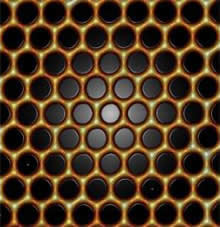Creating molecular graphene
03 May 2012
 The electrons in graphene behave in ways unlike those in ordinary materials, acting like high-energy, massless particles moving close to the speed of light. Now, researchers at Stanford University and the SLAC National Accelerator Laboratory have developed a way to study this exotic behaviour by creating an analog of graphene in the lab.
The electrons in graphene behave in ways unlike those in ordinary materials, acting like high-energy, massless particles moving close to the speed of light. Now, researchers at Stanford University and the SLAC National Accelerator Laboratory have developed a way to study this exotic behaviour by creating an analog of graphene in the lab.The researchers create this new material by using a scanning tunnelling microscope to arrange carbon monoxide molecules on a smooth copper surface. The CO molecules act like traffic cones to steer the free-flowing copper electrons into a honeycomb shape - creating what the researchers call ''molecular graphene.''
''The main motivation was to realise some exotic fundamental physics - and then some interesting applications - by finely controlling the properties of graphene in a way that's currently impossible in real graphene,'' says Hari Manoharan, associate professor of physics at Stanford University. Better understanding of the physics could eventually lead to new materials and devices with desirable properties. Manoharan and his colleagues published their results in the 15 March 2012 of Nature.
The researchers used their atomic manipulation techniques to tweak the properties of molecular graphene in several ways. They created a transistor out of the material, for example, fabricating a PNP junction. They also opened an energy gap in molecular graphene by alternating the strength of the bonds. Such band gaps are properties inherent to semiconductors.
The researchers also tested a theory put forth by Francisco Guinea of the Institute of Materials Sciences in Madrid, a co-author on the paper. ''He had predicted that if you strain graphene in just the right way, the electrons inside would effectively see a very large magnetic field where no magnetic field is being applied,'' Manoharan says. Indeed, by stretching out the honeycomb shape, they found that the electrons behaved as if they were experiencing a magnetic field of 60 Tesla.
This system of creating ''designer electrons'' provides a way to imbue materials with interesting properties. ''In our experiment, we were transforming those electrons into new particles - Dirac fermions,'' says Manoharan. Dirac fermions prefer to go through an obstacle rather than bounce off. ''If you have a material where electrons don't want to backscatter, but the electrons just naturally want to go around defects, you have a material that's immune from the effects of resistance and heating and so forth,'' Manoharan says.
The new technique ''could open many avenues,'' says Claudio Chamon, professor of physics at Boston University. ''We could build artificial structures and study artificial structures that one could not do before.''






























